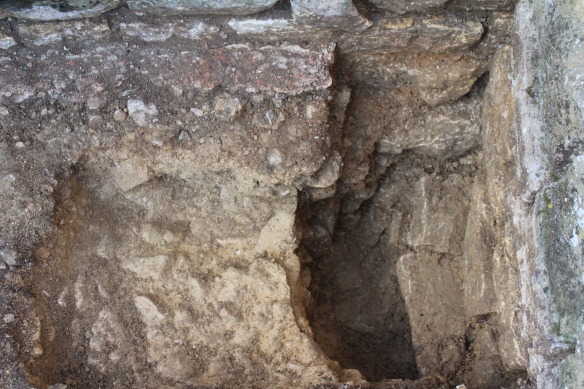We have concentrated on the mosaic in Room 28 but over the next couple of weeks we will open a number of trenches within the central rooms of the Chedworth’s North Range 2. Numbers 27-30. We want to know more about how this part of the villa worked and how the building was extended to the east during the 3rd and 4th centuries.

At the moment we are looking in the east corners of Room 27.

Ranging rod in the NE corner of Room 27 next to the mosaic room 28
We found that very little of the original floor survived but along the north edge we discovered just the last trace of the original opus signinum pink cement floor (no mosaic here).
There were fragments of baked clay in mortar but not the smooth solid level floor which would have been the original surface. The bottom edge of the wall plaster was sandwiched between this and the original Roman wall and it lay above the make up layers of the floor..a fine mortar crust above a crushed layer of limestone fragments set in mortar.

Above the Roman nail (bottom left) and the bird skull (bottom centre) is the white line of the mortar bedding for the remnants of the opus signinum floor (orange red bricky bits)which lies against the line of wall plaster in front of the Roman wall (top right).
This lay above the natural limestone bedrock but this had been cut by the foundation trench for the wall between 27 and 28.

The floor remnant overlying the foundation trench which had been cut through the creamy yellow natural limestone.
So the Roman builders cut a trench…built the wall in it….filled the trench and then laid the floor surfaces.
Excitement! A coin found in the foundation trench filling would date the wall construction…. Little bits of bird and fish bone, a black piece of Roman pottery, couple of bits of painted plaster but no coin this time. We collected bits of charcoal so we could radiocarbon date the construction but not precise enough really. A result of some time from the 3rd to the 5th century would not be very helpful.

The east wall (right) overlies the north wall (top) which has a different rust coloured mortar.
What we could say is that the east wall boundary with 28 was built after the north wall as it’s stones were built over the north wall’s footing. The mortar is a different rusty colour and has been cut away by the east wall foundation trench. Traces of an earlier, lower floor also cut away by the trench.
Ahhhh, the beauty of archaeological relationships and recording sequences of events in the right order (admittedly not everyone’s cup of tea)
But anyway. Here again is the star of the show… the Room 28 mosaic at the end of day 5….


Thank you for such an amazing day, Tuesday; for giving me the unique opportunity to be part of the discoveries-it was a privilege! I’m now watching with close interest all your findings and interpretations. Good luck with the rest of the dig and, fingers crossed, you do get further opportunities in the future!
Hi Helen, Thank you for coming along to dig, it lovely to share what we do, and its great to get your wonderful feedback. 🙂
Excellent updates thank you. Will come over with the family for a look today – and then again before you finish. It is a lovely place to visit at any time.
Hi David, we have permission to excavate the centre part of room 27 so we can see how much mosaic survives so there will be more revealed, see you again soon 🙂